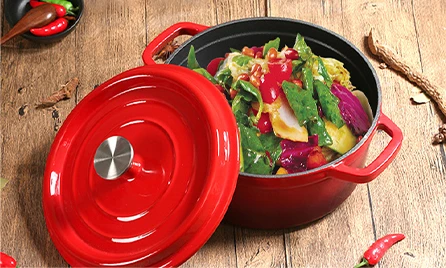
Versatile Cast Iron Dutch Oven for Perfectly Cooked Meals Anytime
The Versatility of Cast Iron Covered Dutch Ovens
Cast iron cookware has been a staple in kitchens for centuries, celebrated for its durability, heat retention, and even cooking capabilities. Among the most beloved pieces in this category is the cast iron covered Dutch oven. From simmering stews to baking bread, this versatile pot plays an essential role in both everyday cooking and gourmet endeavors.
The History and Composition of Cast Iron Dutch Ovens
The Dutch oven finds its roots in 18th-century Europe, where it was used for slow cooking over open flames. Cast iron, a strong and resilient material, was the perfect choice for this purpose. Its ability to withstand high temperatures makes it ideal for searing meat and developing rich flavors. A traditional Dutch oven typically features thick walls and a tight-fitting lid, which help retain moisture, creating a self-basting environment.
Modern Dutch ovens are often enameled, offering a colorful, easy-to-clean finish that doesn't require seasoning as raw cast iron does. This innovation allows for a broader range of cooking methods, from braising to baking, without the risk of food reacting with the iron.
Cooking with a Cast Iron Dutch Oven
One of the major advantages of a cast iron covered Dutch oven is its incredible heat retention. This characteristic makes it perfect for slow-cooking dishes like beef stew or coq au vin. With a thick bottom and heavy lid, it maintains a consistent temperature, allowing flavors to deepen over time. This slow cooking process is essential for tenderizing tougher cuts of meat and infusing dishes with complex flavors.
Moreover, Dutch ovens are stovetop-to-oven capable, which opens up a world of culinary possibilities. You can start a dish on the stovetop—sautéing onions and garlic, for instance—then transfer it to the oven for baking. This functionality is particularly useful when making casseroles or even artisan breads. In fact, many home bakers swear by using a Dutch oven for baking bread, as the sealed environment allows for the perfect rise and crust formation.
cast iron covered dutch oven

Ease of Use and Maintenance
When it comes to cleaning and maintaining a cast iron covered Dutch oven, there are a few key points to consider. For enameled varieties, simply using warm, soapy water and a soft sponge is usually sufficient. Avoid abrasive cleaners or scouring pads to keep the enamel intact.
For traditional bare cast iron, seasoning is crucial. After cleaning, it’s vital to dry the pot thoroughly and apply a light coat of vegetable oil to protect it from rust. Over time, the seasoning will create a non-stick surface, improving the pot’s cooking performance and enhancing flavors.
Sustainability and Heritage Cooking
Investing in a cast iron covered Dutch oven is not only a culinary decision but an environmentally conscious one. Cast iron cookware is built to last—many pieces are handed down through generations, acquiring a history and character unique to their usage. This aligns with the growing trend towards sustainable cooking, as using durable items reduces waste and encourages mindful cooking practices.
Conclusion
Whether you're a novice cook or a seasoned chef, a cast iron covered Dutch oven is an invaluable addition to your kitchen arsenal. Its adaptability makes it suitable for a wide range of dishes, from hearty winter casseroles to artisan crusty bread. Embracing the time-honored tradition of cooking with cast iron can transform your culinary experiences, bringing depth and flavor to every meal.
With just a simple piece of cookware, you can explore diverse cuisines, reignite familial recipes, and create new memories around the dinner table. The cast iron covered Dutch oven isn't just a cooking tool; it's a bridge to the past, a testament to craftsmanship, and a perfect companion for anyone looking to enhance their cooking journey. So, whether simmering, baking, or braising, the Dutch oven stands as a versatile and essential kitchen companion, ready to elevate your culinary creations.
-
Season Cast Iron Perfectly with GPT-4 Turbo TipsNewsAug.01,2025
-
High Quality Cast Iron Cookware - Baixiang County Zhongda MachineryNewsAug.01,2025
-
Premium Cast Iron Pan: Durable & Perfect HeatNewsAug.01,2025
-
High Quality Kitchen Durable Black Round Cast Iron Cookware Pancake Crepe Pan-Baixiang County Zhongda Machinery Manufacturing Co., Ltd.NewsAug.01,2025
-
Cast Iron Cookware - Baixiang County Zhongda Machinery | Nonstick, Heat ResistanceNewsAug.01,2025
-
High Quality Kitchen Durable Black Round Cast Iron Cookware - Baixiang County Zhongda Machinery | Non-Stick, Heat Retention, DurableNewsJul.31,2025


